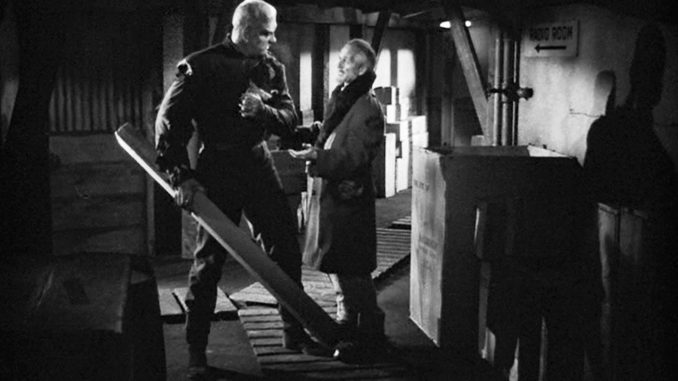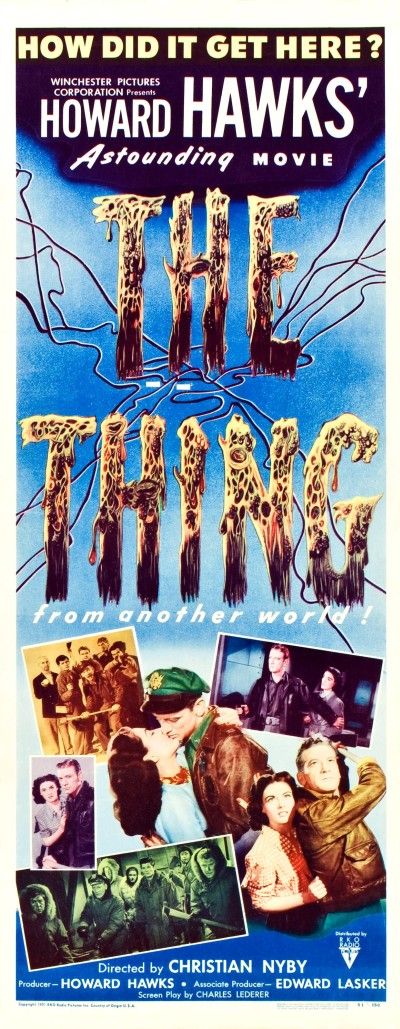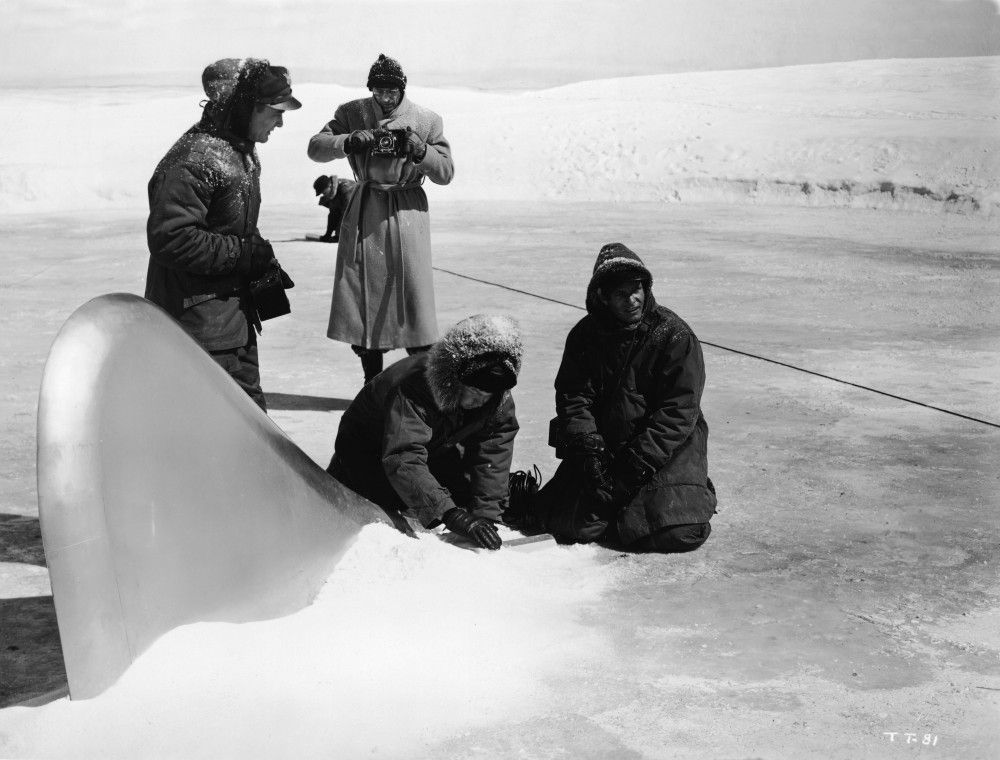
Rating: B
Dir: Christian Nyby
Star: Kenneth Tobey, Robert Cornthwaite, Margaret Sheridan, Douglas Spencer
It’s always going to be difficult to write about this, because the eighties remake is, to me, superior. [Not for the last time I’ll say that in this feature either] The Thing is the finest sci-fi/horror movie ever made, with John Carpenter at the top of his game, and Rob Bottin’s practical effects remain unmatched over forty years later. It’s a remake done right, bringing genuinely new aspects to the table. Yet while I was watching the original, I can see how the remake honours its spirit too. For instance, Carpenter reused the stark title sequence here, the letters burning through the screen from behind to spell out THE THING, before “From Another World” appears, almost as an afterthought. That phrase was added by producer Howard Hawks to distinguish the film from popular song “The Thing”.
The remake renders the second part of the title irrelevant, because we have already seen the spaceship plummet to Earth. The original takes a more leisurely approach, beginning in Anchorage in front of a roaring fireplace, where some of the main characters are playing poker. These include Captain Pat Hendry (Tobey) and journalist Ned Scott (Spencer), the latter tagging along when Hendry is ordered to fly up and assist a research facility near the North Pole. Its head, Dr. Carrington (Cornthwaite), has requested help after reporting a plane crashing nearby. On the way, Hendry experiences a major magnetic anomaly, and on arrival learns from Carrington it’s the equivalent of twenty thousand tons of iron. Yet it changed course on the way in, something a meteor couldn’t do.
 One significant difference in the original is the presence of actual women. The most significant is Nikki Nicholson (Sheridan), Carrington’s secretary, with whom Hendry had previously had a fling. They rekindle their relationship, which consists of her tying his hands behind his back, and feeding him shots. I did not expect to see light bondage in this. There’s also Mrs. Chapman, wife of a scientist, and that’s a total of four more breasts than the remake managed. If they don’t do much, beyond serve coffee and take notes, their mere presence creates a different dynamic to the remake. Though I wouldn’t go as far as Noah Berlatsky of The Atlantic, who wrote that giving Kurt Russell a love interest there would “ruin the apocalyptic, eroticized, male hot-house orgy of Thingness.” Get a room, weirdo.
One significant difference in the original is the presence of actual women. The most significant is Nikki Nicholson (Sheridan), Carrington’s secretary, with whom Hendry had previously had a fling. They rekindle their relationship, which consists of her tying his hands behind his back, and feeding him shots. I did not expect to see light bondage in this. There’s also Mrs. Chapman, wife of a scientist, and that’s a total of four more breasts than the remake managed. If they don’t do much, beyond serve coffee and take notes, their mere presence creates a different dynamic to the remake. Though I wouldn’t go as far as Noah Berlatsky of The Atlantic, who wrote that giving Kurt Russell a love interest there would “ruin the apocalyptic, eroticized, male hot-house orgy of Thingness.” Get a room, weirdo.
In the middle is where the films probably are most similar. There’s an expedition out to the crash site, where they discover an alien craft has crash-landed, and find its occupant frozen in the ice nearby. This is then brought back to base, and allowed to defrost, at which point things go inexorably bad. The major difference is the creature here takes only one form. The original intent was to have it a shapeshifter, as in John W. Campbell’s original novel, but this proved unfeasible within the available budget. The results are where the remake outstrips this by the largest margin, because the alien looks more like a third-rate Frankenstein knock-off, and you understand why it’s properly on-screen for only a few minutes in the entire movie. It’s not so much “Less is more,” as “Less is less bad.”
In addition, this means the original doesn’t have the sense of paranoia which pervades Carpenter’s version, where anyone could be infected, and nobody trusts anyone else. That’s replaced with a more straightforward conflict: us vs. them. Or most of us, anyway. Dr. Carrington is strongly opposed to Hendry’s desire to destroy the alien, attempting to sabotage this by turning off the electricity. He even attempts to befriend the monster at the end (top), and gets slapped silly for his pains. The message is clear, and fairly xenophobic. The Other cannot be trusted, presents an implacable threat, and must be fought by every means available. “Keep watching the skies,” warns Scott at the end, preaching eternal vigilance against America’s enemies – be they domestic, foreign or extra-terrestrial. It’s a contrast to the remake, where the threat is internal, literally and figuratively.
A bit like Poltergeist, there’s some debate as to whether the credited director was responsible for the film or not. Tobey maintained that it was Hawks who was really calling the shots, though James Arness, who played the creature before going on to fame in Gunsmoke, says it was Nyby. There are certainly elements which appear to be in Hawks’ style: the machine-gun, overlapping dialogue sounds very similar to His Girl Friday. The motivation is supposed to be that it would let his protegé get his Director’s Guild membership. Hawks did keep close to 90% of the directorial fee allocated by the studio. But Nyby flatly rejects such questions, calling the inquiry, “One of the most inane and ridiculous questions I’ve ever heard.” I’d give Nyby the benefit of the doubt, and say Hawks likely provided many helpful suggestions.
 Though it went in a different direction to Carpenter, it’s almost as tense, with the team trying to figure out how to defeat an enemy impervious to normal weapons. The antagonist is smart too, disabling the facility’s heating system, in an effort to freeze the humans out, which adds a ticking clock to the mix. That it feeds on blood, gives an icky component, enhancing the horror vibe [I need hardly remind you about the importance of blood in the remake]. There have been rumours of a deleted scene showing its victims in the greenhouse: “They’re hanging upside down, like in a slaughterhouse”, says Hendry. However, Cornthwaite denies such a sequence was ever filmed.
Though it went in a different direction to Carpenter, it’s almost as tense, with the team trying to figure out how to defeat an enemy impervious to normal weapons. The antagonist is smart too, disabling the facility’s heating system, in an effort to freeze the humans out, which adds a ticking clock to the mix. That it feeds on blood, gives an icky component, enhancing the horror vibe [I need hardly remind you about the importance of blood in the remake]. There have been rumours of a deleted scene showing its victims in the greenhouse: “They’re hanging upside down, like in a slaughterhouse”, says Hendry. However, Cornthwaite denies such a sequence was ever filmed.
Despite the weakness of the monster – Arness largely refused to discuss the film thereafter – there is a good amount to enjoy here. The screenplay, by Charles Lederer, with help from Hawks and Ben Hecht, fizzes along, and is still very capable of holding a modern viewer’s interest. It’s not The Thing, of course. But, then again, what is?
This article is part of our October 2025 feature, 31 Days of Vintage Horror.
